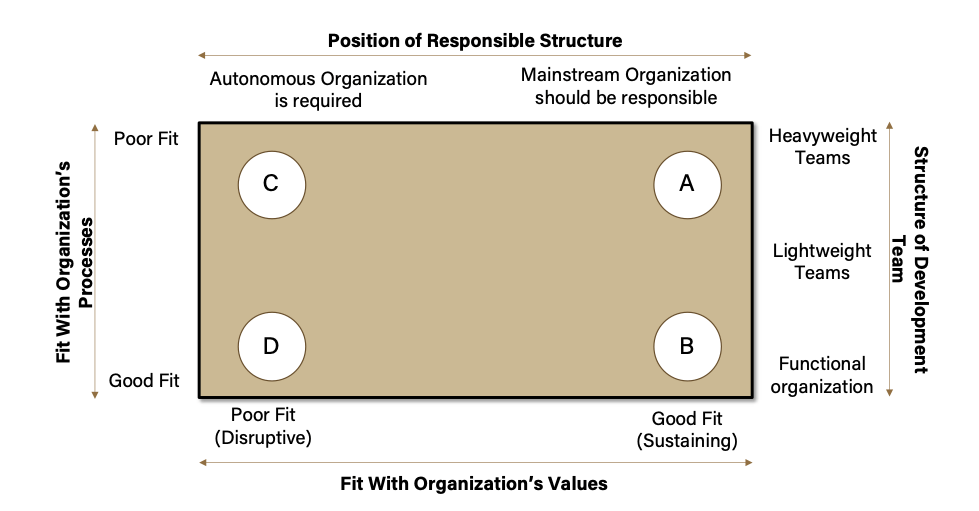Reviewer
Dr. Lourival Carmo Monaco Neto, Postdoctoral Research Associate
Article
Break Out to Open Innovation by Denis Bettenmann, Ferran Giones, Alexander Brem and Philipp Gneiting
Journal
MIT Sloan Management Review, Winter 2022
Summary
We reached a time when most companies, especially those winning in their industries, realized their businesses are fated to fail without innovative efforts. But this realization alone is not enough. Companies must understand the paths and strategies to incorporate an innovation-driven approach to conducting their business.
This is exceptionally challenging for most incumbent companies, as the resources, processes and values that drove them to their winning positions are not the same as those that will lead to innovations (especially disruptive ones).
In this sense, companies must understand the possible organizational structures that will lead to the desired innovative outcomes. These structures can range from an internal department focused on innovation all the way down to the creation/hiring of an autonomous organization (Figure 1). Every choice in this pathway presents pros and cons. For instance, a completely internally-driven initiative will give the organization total control of innovations but, at the same time, will make it slow and hard to operate since as it will need to be evaluated in terms of the existing resources, processes and values of the company. On the other hand, creating or partnering with an outside entity will allow for a nimble structure that can iterate quickly and “fail fast” to find more interesting solutions to challenges; however, it will also diminish a company’s control over the solutions created and their fit to its business.
Figure 1 – A Framework for Finding the Right Innovation-Focused Organizational Structure
 Source: Christensen and Raynor, 2003
Source: Christensen and Raynor, 2003
In 2016, Mercedes-Benz AG faced this same challenge — trying to understand the best pathway for its innovation strategy. The company realized collaborating with external entities such as startups was a powerful way to access potential innovative ideas without interfering with its core business and the resources, processes and values that drove it to its current position in the industry.
Mercedes’ choice was to create an open innovation corporate accelerator (CA), joining forces with partners from academia and industry. This open CA brought together multiple sponsoring companies, which led to a more attractive space for startups.
The open CA design differs from a conventional CA in two principal ways. First, it emphasizes and accelerates the strategic fit between sponsors and startups by nurturing only innovations that fill a gap in a sponsor’s products and processes instead of making a less-focused equity investment in the startup itself. Second, it harnesses the network effects of open innovation and platforms by inviting the participation of multiple sponsors, startups and other stakeholders rather than establishing exclusive sponsor-startup relationships.
There are three main phases of the open CA model adopted by Mercedes:
- Scouting and Selection: Matching startup technologies to business unit needs is the defining challenge in the first phase of the open CA process.
- Solution Adaptation: The defining challenge of the second phase of the CA process is proving a startup’s solution can fill specific sponsor (in this case, the business unit) needs.
- Solution Integration: The defining challenge of the final phase of the CA process is implementing the solution at scale.
Finally, Mercedes’ open CA model offers a few interesting insights. It:
- Builds internal commitment to external innovation.
- First, the CA team helps identify existing technological “white spaces” within the business units. Once a white space is specified, the CA team helps the business unit fill it by actively searching for possible solutions.
- Second, the staff time and funding needed to engage in POC projects come from the business unit.
- Third, the CA team ensures the business unit’s commitment to external innovation is rewarded.
- Embraces co-opetition.
- Maximizing the benefits from the open CA model requires an explicit willingness to establish cooperative relationships with competitors.
- Chooses a playing field.
- Sponsors in an open CA can improve results by setting parameters for the kinds of startups, technologies and applications they pursue.
What this mean for Food and Agricultural Business
Agriculture and food companies need innovation as much as (or even more) than any other company in any industry, and they have also come to acknowledge this necessity; however, due to many factors, they have experienced difficulties in creating strategies and pathways to achieve such innovations.
Although these companies have allocated vast amounts of resources to spur innovative initiatives, it has become clear that doing it internally and individually is not an effective way to achieve this goal. Further, if creating an effective and synergistic innovative ecosystem is what we need in this industry, creating silos of internal innovation will not be enough.
We need to focus our efforts on collaborative and “open” initiatives, incentivizing coopetition so that challenges beyond individual organizations can be tackled without losing sight of our everyday jobs to be done. Mercedes’ example of an open CA is one of several strategies to elevate the search for innovation to something bigger and more meaningful than just a new feature, product or service. It was able to bring competitors together to achieve an innovation ecosystem that attracted entrepreneurs and startups to solve their challenges and, simultaneously, incentivized use-inspired innovation, generating value for all parts involved in the process.
Of course, this is not the only model for innovation-driven processes in incumbent companies. Examples such as partnering with venture studios, spinning out startups from internal innovation challenges and many others are possible. Therefore, the question we must ask should never be, “Should we innovate?” Instead, it should be, “What is the best way to innovate?”




